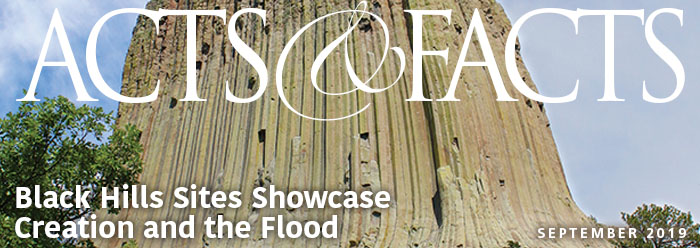Around 150 years ago, Charles Darwin asserted that “no organism wholly soft can be preserved.”1 He concluded this based on the assumption that fossilization required long periods of time.
The reality is, however, that fossilization must occur rapidly, at a faster rate than the specimen would decay. Darwin’s belief in vast geological ages, borrowed from Charles Lyell and perhaps from his grandfather Erasmus, led to his misinterpretation that fossils form slowly and gradually. Since Darwin’s time, however, many organisms that were “wholly soft” have been found preserved and fossilized, and by far the best explanation for their formation is not through slow and gradual means, but rapid and catastrophic ones.
Although extremely uncommon, worms, jellyfish, bacteria, a host of different kinds of leaves, and now three exquisitely preserved octopods have been found in fossilized form.2 Discovered in Lebanon, these wholly soft-bodied animals must have been rapidly engulfed by watery sediments. The mud that encased them turned to stone, preserving the octopod impressions before the creatures could rot.
These specimens provide strong testimony for a rapid fossilization process. Soft tissue fossils have long been a problem for those who believe that sedimentary deposits represent vast ages. For example, paleontology research at the University of Leicester refers to the soft-body phenomenon as an “ancient mystery.” The university stated in 2008 that “the Burgess Shales preserved soft tissue in exquisite detail, and the question of how this came to happen has troubled scientists since the discovery of the fossils in 1909.”3 Interestingly, university researchers solved this “mystery” by suggesting “rapid sedimentation of up to decimetre-thick units at this location from pulsatory, quasi-continuous density currents.”4
In addition to “wholly soft” creatures found in fossilized form, preserved soft body parts—such as the fossilized brains of a T. rex and an extinct fish—have been discovered, and Nature recently reported on “exceptional soft-tissue preservation in a theropod from Italy.” 5, 6 The rock layers that contain these fossils could not have taken long ages to form, because these creatures would have decayed too quickly to have been preserved the way they exist today. The “rapid sedimentation” cited by the University of Leicester researchers would, however, be consistent with a widespread deluge, such as Noah’s Flood.
Since there is no record of vast eons in these rocks,7 and the only answer to the mystery of fossilized soft tissue matches the account of catastrophe already given in God’s Word, perhaps it is time to discard the unfounded and outdated concept of long geological ages.
References
- Darwin, C. R. 1859. The Origin of Species. Middlesex, England: Penguin Classics, 298.
- Fuchs, D., G. Bracchi, and R, Weis. 2009. New Octopods (Cephalopoda: Coeoidea) from the Late Cretaceous (Upper Cenomanian) of Hâkel and Hâdjoula, Lebanon. Paleontology. 52 (1): 65-81.
- Macedo-Hatch, T. Ancient mystery solved by Leicester geologists. University of Leicester press release, February 22, 2008.
- Gabbott, S.E., J. Zalasiewic, and D. Collins. 2008. Sedimentation of the Phyllopod Bed within the Cambrian Burgess Shale Formation of British Columbia. Journal of the Geological Society. 165 (1): 307-318.
- Thomas, B. What Does It Take to Fossilize a Brain? ICR News. Posted on icr.org on March 11, 2009, accessed March 24, 2009.
- Dal Sasso, C., and M. Signore. 1998. Exceptional soft-tissue preservation in a theropod from Italy. Nature. 392 (6674): 383-387.
- Morris, H.M. 1976. Up with Catastrophism! Acts & Facts. 5 (8).
* Mr. Thomas is Science Writer at the Institute for Creation Research.
Article posted on April 1, 2009.
















